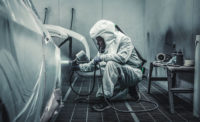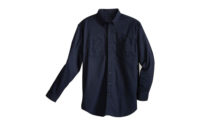My foreman asked me to clean debris from the floor of an empty storage tank that contained fumes. When I put the facemask on, I immediately felt uncomfortable and isolated. I was very aware of my breathing due to the noise made by air coming into the facemask and my breath exiting the mask. The cylinder of air hanging on my back felt really heavy and made it hard to bend over.
I could feel myself breathing faster and faster. Finally, a bell went off signaling that the air cylinder was low. I was glad to get out of the tank and remove the equipment. The floor wasn’t too clean, but I told the boss it looked okay because I didn’t want to do the job again.
I’ve had to wear respiratory equipment many times since then, and I’ve learned that proper use of the equipment is vital. In this article, I want to talk about the importance of training and overcoming any employee resistance to respiratory protection. After all, the equipment performs critical functions.
What's available?
Employees first need to be aware of the general types of respiratory equipment available and the situations in which they should be used:- Air-purifying respirators remove contaminants from breathing air. They are designed and selected on the basis of the properties of the contaminants they protect against — gases and vapors; particulates such as dust and mist; and combinations of gas, vapor and particulates.
- Air-supplied respirators provide clean air from an outside source or from an air tank.
- Combination air-supplying/air-purifying respirators may provide both functions.
Give a pop quiz
Keeping this information in mind, ask yourself and your employees what you would do if required to handle the following task: Water that is used in a cooling tower basin is treated with chlorine that is supplied by cylinders. There are always two cylinders in place, but one is empty and you need to put the spare cylinder in service.Scenario one:You locate and put on a respirator and air cylinder, and ask a co-worker to stand by wearing the same equipment. You then close the valve on the empty cylinder and, using a wrench, disconnect a metal flex hose. The flex hose is then connected to the spare bottle and the valve is opened. Using a spray bottle of ammonia, you check the fitting for leaks. If no leaks are found you remove the respiratory equipment, clean it, and, if needed, replace the air cylinder.
Scenario two: You don’t use respiratory equipment and don’t ask a co-worker to stand by. You simply stand upwind and perform the same cylinder change-out. If there is any leak when you open the fresh cylinder, you hold your breath for a few seconds while you close the valve.
It’s obvious that the first scenario is the safe way to do the task. But you might be surprised by how many people will go with the easier, but unsafe, option. Why?
The most-often cited reasons for not wearing respiratory protection include:
- “I didn’t know any better.”
- “Respiratory equipment is uncomfortable.”
- “My co-workers didn’t use them.”
- “When I didn’t wear a respirator, I didn’t suffer negative effects.”
Proper training = proper use
Whatever the reason for not wearing respiratory equipment, the gear is vital for proper protection. And training is the only way to teach employees how important it is.Employees need to be trained in two areas: correct use of respiratory equipment and the real-world hazards of the chemicals they are working with.
Correct use: This should be a hands-on training activity. Some of the best respiratory training is seen in fire fighting classes. Firefighters’ frequent use of fresh air cylinders and facemasks makes their training very important. Students leave the classes knowing how to don the equipment and wear it correctly. Knowing how to adjust the various belts and how high to carry the cylinder on your back is very important.
Real world hazards: Simply reviewing chemical data sheets and mentioning various levels of contaminants doesn’t mean much to people. On the other hand, relating contaminant levels to everyday measurements can be helpful. For example, if you said 100 parts per million of a chemical will cause vomiting, it would be hard to imagine the quantity you’re talking about. But if you said an eyedropper of that chemical sprayed in a 10- by 10-foot room would cause vomiting, it’s easier to visualize.
Most trainers tend to focus on data presented on the hazard sheets, which are usually difficult to understand. Long-term effects of the chemicals being handled need to be described in detail because it’s hard to relate to problems that may occur 20 years after failure to wear proper respiratory protection.
Remember, you owe it to your employees to make sure that they know all the facts about respiratory protection. When employees aren’t properly informed about how to use respirators — and why it’s critical — they are less likely to suit up when it’s really necessary.
Sidebar: Buying online a respirator
You can buy just about anything — food, books, computers, and even a half-face negative pressure respirator — over the Internet. But how does purchasing respiratory protective equipment online stack up against traditional methods like face-to-face meetings with sales reps, product literature reviews, and using purchasing orders?We decided to fire up our modems and see for ourselves. To be a viable alternative, online purchasing should be faster, convenient, traceable, and accurate. So, for our experiment, we wanted to select the respirator, review pricing, and have it ordered in an hour.
Not surprisingly, we found online purchasing to be an efficient and convenient option. We were able to select a half-face respirator and complete the online ordering within an hour and five minutes. But more important, we learned a few lessons (see sidebar) we hope will help you with future Internet purchases.
Our little experiment
First, we selected two common search engines, Yahoo! and America Online, and limited our search to three commonly used respirators.Surprisingly, most of the allotted hour — about 40 minutes — was spent searching for the manufacturers’ Web pages. All of these pages listed product information and sales contacts.
But we were hoping for respirators at the click of the mouse, which was not the case, because links to vendors and online catalogs were not available on any of the manufacturers’ sites. These sites only allowed us to review product technical data on three comparable respirators from three different manufacturers. Pricing information and online ordering were not available.
Finally, we tried a global search for vendors of our selected manufacturers. This is where we found the most information. We selected the first 20 vendors in order to keep to our allotted time. Pricing was available on the majority of these sites, but only three had online catalogs, two of which required pre-registration.
We purchased the respirator from the site that didn’t require online registration and found that completing the online ordering form was much faster than filling out a standard purchase order.
By Paul Watson, CIH, CET
By no means was our field test scientific, but it did prove that ordering online can speed the purchasing process. But a little up-front work, including establishing relationships with an on-line vendor and instituting purchasing controls, is needed to make it truly efficient.
Paul Watson, CIH, CET, is the industrial hygiene manager for Adirondack Environmental Services, Inc. Adirondack is a full-service environmental consulting firm and AIHA-accredited laboratory in Albany, N.Y.; (518) 580-1930.


